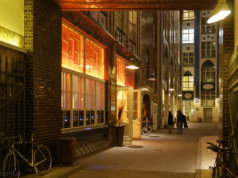The State Bauhaus, or more commonly known as simply “Bauhaus”, was the most influential modernist art schools of the twentieth century.
Today, you can find works inspired from its philosophy all over the world. In Berlin specifically, there are more than a dozen architectural and art pieces created by founder Walter Gropius. Now, with the help of a handy new app, you can visit them all.
What is the Bauhaus?
You may have heard of it before, but aren’t sure exactly what it means. The Bauhaus (literally translated to “construction house”) was a school of arts founded by Gropius in the German city of Weimar in 1919.
It later moved to Dessau in 1925 and then Berlin in 1932. It was shut down in 1933 under pressure from the Nazi regime. Although it was only open from 1919 to 1933, the staff and students continued to spread its philosophies. The styles had a major impact in Western Europe, the United States, Canada and Israel.
From its inception, the teachings were an innovative approach to understanding art’s relationship to society and technology.
It was largely influenced by the Arts and Crafts movement of the 19th and 20th century. One main focus on reinforcing the bond between creativity and manufacturing. This was especially linked to the relationship between form and function, and the school sought to build a complete harmony between the function of an object or building and its design.
Although an architect founded the school, the early years of its existence did not include an architectural department. Rather, its foundations were based around creating a “total” work of art in which all forms of art. Architecture would be eventually merged together.
Later on, the Bauhaus style played an incredibly influential role in modern design, modernist architecture and art, and subsequently graphic design, interior design, industrial design and typography.
Discovering the Bauhaus in Berlin
![Bauhaus Archiv in Berlin. By janine pohl (Own work) [CC BY-SA 2.5 (http://creativecommons.org/licenses/by-sa/2.5)], via Wikimedia Commons.](https://www.berlinjournal.biz/wp-content/uploads/2016/10/Bauhaus-Archiv-Berlin.jpg)
From October 7, the free app “Gropius to Go” will guide visitors throughout the web of Berlin’s most significant Bauhaus art and architectural landmarks. It will be available for both iOS and Andriod.
Included in the app is information on the school itself and its founder Walter Gropois. As well it will include interactive maps of all of Gropius’ buildings and works of art throughout the city.
Most influential Bauhaus pieces
Countless works of art and architecture may have been inspired by the Bauhaus philosophy and design. Here are few that came straight from the school itself.
-
Bauhaus building in Dessau (1919-1925)

The school’s complex in Dessau has come to be viewed as the a landmark in modern and functional architectural design.
-
Club Chair (Model B3) (The Wassily Chair) (1925)
![Wassily Chair. Taken by Spyrosdrakopoulos (Own work) [CC BY-SA 4.0 (http://creativecommons.org/licenses/by-sa/4.0)], via Wikimedia Commons](https://www.berlinjournal.biz/wp-content/uploads/2016/10/Wassily-Chair-Bauhaus.jpg)
-
Universal Bayer (1925)

The artist, Herbert Bayer, created a typography that was simple and classic, moving away from the traditional medieval-style font. He also only created it in lower case, believing that uppercase letters were redundant as no phonetic distinction was made between the two.























